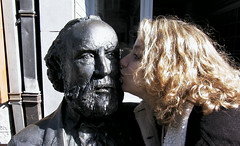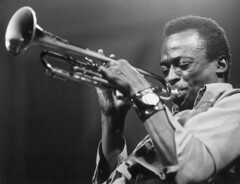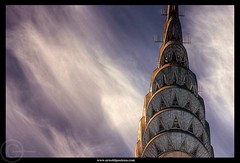Style show: a project for 2nd semester:
- a multi-media dress-up show.
- each Fine Arts student would be a model in this show.
- find a style that includes a blazer or vest or sweater and that reflects casual elegance.
- your appearance will be accompanied by a projected presentation.
- include images of variations on the look you have chosen.
- include remarks from your
* mother
* father
* style-conscious classmate
- include brief musical background.
- include a reference that connects your style to classical apparel.
- show will be presented to classmates in arts-related classes.
A reference story from the New York Times.
Style show will be preceded by a unit on the history of apparel. Eras upon which we will peer:
Greek
Roman
Chinese
Medieval
Renaissance
Reformation
Industrial Revolution
turn-of-the-century
Roaring Twenties
WWII
Fifties
Late 60's
80's
Friday, December 18, 2009
Mozart and Bach: describing the differences between the 2 giants of classical music
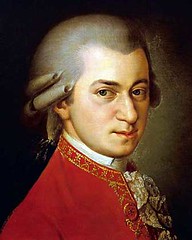
Johannes Chrysostomus Wolfgangus Theophilus Mozart (January 27th, 1756 - December 5th, 1791)
Originally uploaded by violinsoldier
You will hear the music of these two composers in every phase of your life. My goal is to enable you to have a clear and concise way of distinguishing between them.
- Include the titles of their well-known tunes, aka their works or pieces.
- Use no less than 10 images. Edit the biographical material so that each image has about 4 brief items.
- Document. List all the sites that provide your material.
- Think in terms of presenting this project to a Magnet history class.
Thursday, December 17, 2009
Saxophones would be hellaciously long if they weren't curved
The saxophone is a conical-bored transposing musical instrument considered a member of the woodwind family, says Wikipedia.
Saxophones are usually made of brass and are played with a single-reed mouthpiece similar to that of the clarinet. The saxophone was invented by Adolphe Sax in 1841.
He wanted to create an instrument that would both be the loudest of the woodwinds and the most versatile of the brass, and would fill the then vacant middle ground between the two sections.
The simplest design of saxophone is a straight conical tube, and the sopranino and soprano saxophones are usually of this straight design. However, as the lower-pitched instruments would be unacceptably long if straight, for ergonomic reasons the larger instruments usually incorporate a U-bend at or slightly above the third-lowest tone hole. As this would cause the bell of the instrument to point almost directly upwards, the end of the instrument is either beveled or tilted slightly forwards. This U-shape has become an iconic feature of the saxophone family, to the extent that soprano and even sopranino saxes are sometimes made in the curved style even though this is not strictly necessary.
Saxophones are usually made of brass and are played with a single-reed mouthpiece similar to that of the clarinet. The saxophone was invented by Adolphe Sax in 1841.
He wanted to create an instrument that would both be the loudest of the woodwinds and the most versatile of the brass, and would fill the then vacant middle ground between the two sections.
The simplest design of saxophone is a straight conical tube, and the sopranino and soprano saxophones are usually of this straight design. However, as the lower-pitched instruments would be unacceptably long if straight, for ergonomic reasons the larger instruments usually incorporate a U-bend at or slightly above the third-lowest tone hole. As this would cause the bell of the instrument to point almost directly upwards, the end of the instrument is either beveled or tilted slightly forwards. This U-shape has become an iconic feature of the saxophone family, to the extent that soprano and even sopranino saxes are sometimes made in the curved style even though this is not strictly necessary.
Jazz would not be quite that same without the work of Adolphe Sax in the 1800's
Antoine-Joseph "Adolphe" Sax (November 6, 1814 – February 4, 1894[1]) was a Belgian musical instrument designer and musician who played the flute and clarinet, and is best known for inventing the saxophone, says Wikipedia.
He patented the saxophone in 1846.
Composer Hector Berlioz wrote approvingly of the new instrument in 1842.
By 1846 Sax had designed, on paper, a full range of saxophones (from sopranino to subcontrabass). Although they never became standard orchestral instruments, the saxophones made his reputation, and secured him a job teaching at the Paris Conservatoire from 1867.
He patented the saxophone in 1846.
Composer Hector Berlioz wrote approvingly of the new instrument in 1842.
By 1846 Sax had designed, on paper, a full range of saxophones (from sopranino to subcontrabass). Although they never became standard orchestral instruments, the saxophones made his reputation, and secured him a job teaching at the Paris Conservatoire from 1867.
John Coltrane, one of the most powerful and influential jazz saxophonists
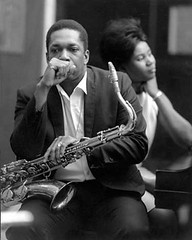
John Coltrane and Alice Coltrane during the 1960s. The couple made monumental contributions in the field of music and social consciousness.
Originally uploaded by Pan-African News Wire File Photos
Working in the bebop and hard bop idioms early in his career, Coltrane helped pioneer the use of modes in jazz and later was at the forefront of free jazz.
He was prolific, making about fifty recordings as a leader during his recording career, and appeared as a sideman on many other albums, notably with trumpeter Miles Davis and pianist Thelonious Monk. As his career progressed, Coltrane's music took on an increasingly spiritual dimension. His second wife was pianist Alice Coltrane, and their son Ravi Coltrane is also a saxophonist.
He influenced innumerable musicians, and remains one of the most significant tenor saxophonists in jazz history.
As a teen he left his home in High Point, NC, and moved to Philadelphia. He studied music; he enlisted in the Navy.
In 1945 he saw Charlie Parker perform for the first time. In a DownBeat article in 1960 he recalled: "the first time I heard Bird play, it hit me right between the eyes.
Miles Davis found him and invited him to join his quintet. In 1956 they did the albums issued as Cookin', Relaxin', Workin', and Steamin', some of the most treasured titles in Davis's early discography. The group disbanded in mid April due partly to Coltrane's problematic heroin addiction.[1]
During the later part of 1957 Coltrane worked with Thelonious Monk at New York’s Five Spot, a legendary jazz club, and played in Monk's quartet. The resulting album, Thelonious Monk Quartet with John Coltrane at Carnegie Hall, has been widely acclaimed.
Coltrane rejoined Davis in January 1958. In October 1958, jazz critic Ira Gitler coined the term "sheets of sound" to describe the style Coltrane developed during his stint with Monk and was perfecting in Miles' group, now a sextet. His playing was compressed, with rapid runs cascading in hundreds of notes per minute. During this time he performed on Kind of Blue, and the live recordings Miles & Monk at Newport and Jazz at the Plaza.[1]
Coltrane recorded his first album comprising his own compositions exclusively, Giant Steps. The title track is generally considered to have the most complex and difficult chord progression of any widely-played jazz composition.
With Atlantic Records, for whom he had recorded Giant Steps, his first record with a new group was also his debut playing the soprano saxophone; the album was the hugely successful My Favorite Things.
In the early 1960's he recorded for Impulse Records and expanded his experimental style. Critics were fiercely divided in their estimation of Coltrane. Audiences, too, were perplexed; in France he was famously booed during his final tour with Davis. In 1961, Down Beat magazine indicted Coltrane, along with Eric Dolphy, as players of "Anti-Jazz" in an article that bewildered and upset the musicians.
He responded by making albums which were more conservative and accessible. He recorded an album of ballads and participated in collaborations with Duke Ellington on the album Duke Ellington and John Coltrane and with deep-voiced ballad singer Johnny Hartman on an eponymous co-credited album.
His quartet produced their most famous record, A Love Supreme, in December 1964. A culmination of much of Coltrane's work up to this point, this four-part suite is an ode to his faith in and love for God. These spiritual concerns would characterize much of Coltrane's composing and playing from this point onwards, as can be seen from album titles such as Ascension, Om and Meditations.
Recordings in the first half of 1965 show Coltrane's playing becoming increasingly abstract, with greater incorporation of devices like multiphonics, utilization of overtones, and playing in the altissimo register, as well as a return to Coltrane's sheets of sound. In the studio, he abandoned his soprano to concentrate on the tenor saxophone. In addition, the quartet responded to the leader by playing with increasing freedom.
In 1965 Coltrane may have begun using LSD[8][9] - informing the sublime, "cosmic" transcendence of his late period, and also its incomprehensibility to many listeners. Drummer Philly Joe Jones's and pianist McCoy Tyner's departed. Coltrane and saxophonist Pharaoh Sanders were described by Nat Hentoff as "speaking in tongues". When touring, the group was known for playing very lengthy versions of their repertoire, many stretching beyond 30 minutes and sometimes even being an hour long. Concert solos for band members regularly extended beyond fifteen minutes in duration.
Coltrane died from liver cancer at Huntington Hospital on Long Island in 1967, at the age of 40. Biographer Lewis Porter has suggested, somewhat controversially, that the cause of Coltrane's illness was hepatitis, although he also attributed the disease to Coltrane's heroin use.[10]
Tuesday, December 15, 2009
History of jazz presentation using Miles Davis and one additional figure
With a partner, please develop a 10-image history of jazz presentation in Google Docs.
* Using 3 bulleted items per image, compare the fine arts impact of Miles Davis to another 20th century musical artist. Each student will use 4 images in developing the biography and one image on comparison.
* Document each slide in fine type at the lower edge.
* Due at the end of the hour. 3 pts.
* Though the project must be filed in your GoogleDocs, please do Not send notification to trudeau11.
20th century cats -
- Duke Ellington
- John Coltrane
- Igor Stravinsky
- Aaron Copeland
- Billie Holiday
- Ella Fitzgerald
- Nat King Cole
- Jellyroll Morton
- Joe King Oliver
- Wynton Marsalis
- Leonard Bernstein
- Thelonius Monk
- Charlie Parker
For concise biographies, please see the Ken Burns Jazz site.
* Using 3 bulleted items per image, compare the fine arts impact of Miles Davis to another 20th century musical artist. Each student will use 4 images in developing the biography and one image on comparison.
* Document each slide in fine type at the lower edge.
* Due at the end of the hour. 3 pts.
* Though the project must be filed in your GoogleDocs, please do Not send notification to trudeau11.
20th century cats -
- Duke Ellington
- John Coltrane
- Igor Stravinsky
- Aaron Copeland
- Billie Holiday
- Ella Fitzgerald
- Nat King Cole
- Jellyroll Morton
- Joe King Oliver
- Wynton Marsalis
- Leonard Bernstein
- Thelonius Monk
- Charlie Parker
For concise biographies, please see the Ken Burns Jazz site.
Saturday, December 12, 2009
A tour of Manhattan multiple choice test
Choose the best location description - in Manhattan, unless otherwise noted. Please send & save your answers via GoogleDocs.
1. Harlem: a) Above Central Park b) South of Theater District c) Midtown d) Upper West Side.
2. Columbia U.: a) Upper West Side b) Upper East Side c) Midtown d) Harlem.
3. Fifth Ave.: a) Upper West Side b) Upper East Side c) Midtown d) Lower East Side.
4. The Dakota (apt bldg): a) Upper West Side b) Upper East Side c) Midtown d) Harlem.
5. Metropolitan Museum of Art: a) Central Park b) Greenwich Village c) Financial District.
6. Guggenheim Museum: a) Central Park b) Greenwich Village c) Financial District d) SoHo.
7. Plaza Hotel: a) Central Park b) Theater District c) Tribeca d) Upper West Side.
8. Lincoln Center: a) Upper West Side b) Upper East Side c) Midtown d) Harlem.
9. Metropolitan Opera House: a) a) Central Park b) Greenwich Village c) Financial District d) Upper West Side.
10. Rockefeller Center: a) Upper West Side b) Upper East Side c) Midtown d) SoHo.
11. UN Headquarters: a) Hudson R b) East R c) Harlem R d) Long Island Sound.
12. Broadway: a) North-South b) East-West c) Bronx-Manhattan-Brooklyn.
13. Carnegie Hall: a) Upper West Side b) Upper East Side c) Midtown d) SoHo.
14. MoMA / Museum of Modern Art: a) Upper West Side b) Upper East Side c) Midtown d) Lower East Side.
15. Empire State Bldg. is at 34th St and a) Fifth Ave b) Broadway c) 42nd St.
16. Washington Square Park: a) Central Park b) Greenwich Village c) Financial District d) Upper West Side.
17. NYU: a) Central Park b) Greenwich Village c) Financial District d) Upper West Side.
18. Greenwich Village: a) Upper West Side b) Upper East Side c) Above Midtown d) Above SoHo.
19. Chrysler Bldg: a) Upper West Side b) Upper East Side c) Midtown d) Lower East Side.
20. Lower East Side: a) Brooklyn Bridge b) George Washington Bridge c) Lincoln Tunnel d) Staten Is Ferry.
21. Little Italy & Chinatown: a) Upper West Side b) Upper East Side c) Midtown d) Lower East Side.
22. Wall St / Financial District: a) New Amsterdam b) Greenwich Village c) Harlem
d) Upper East Side.
23. NYSE is closer to a) 1st St b) 34th St c) 42nd St d) 155th St
24. Former World Trade Center site closer to: a) Wall St. b) 42nd St c) Brooklyn Bridge d) Fifth Ave.
25. Battery Park: a) Upper West Side b) Upper East Side c) Midtown d) Financial District.
26. New Amsterdam: a) Upper West Side b) Upper East Side c) Midtown d) Financial District.
27. 42nd St: a) Garment District b) Financial District c) Theater District d) Spanish Harlem.
28. Lenox Ave / Malcolm X Blvd: a) Upper West Side b) Upper East Side c) Midtown d) Harlem.
1. Harlem: a) Above Central Park b) South of Theater District c) Midtown d) Upper West Side.
2. Columbia U.: a) Upper West Side b) Upper East Side c) Midtown d) Harlem.
3. Fifth Ave.: a) Upper West Side b) Upper East Side c) Midtown d) Lower East Side.
4. The Dakota (apt bldg): a) Upper West Side b) Upper East Side c) Midtown d) Harlem.
5. Metropolitan Museum of Art: a) Central Park b) Greenwich Village c) Financial District.
6. Guggenheim Museum: a) Central Park b) Greenwich Village c) Financial District d) SoHo.
7. Plaza Hotel: a) Central Park b) Theater District c) Tribeca d) Upper West Side.
8. Lincoln Center: a) Upper West Side b) Upper East Side c) Midtown d) Harlem.
9. Metropolitan Opera House: a) a) Central Park b) Greenwich Village c) Financial District d) Upper West Side.
10. Rockefeller Center: a) Upper West Side b) Upper East Side c) Midtown d) SoHo.
11. UN Headquarters: a) Hudson R b) East R c) Harlem R d) Long Island Sound.
12. Broadway: a) North-South b) East-West c) Bronx-Manhattan-Brooklyn.
13. Carnegie Hall: a) Upper West Side b) Upper East Side c) Midtown d) SoHo.
14. MoMA / Museum of Modern Art: a) Upper West Side b) Upper East Side c) Midtown d) Lower East Side.
15. Empire State Bldg. is at 34th St and a) Fifth Ave b) Broadway c) 42nd St.
16. Washington Square Park: a) Central Park b) Greenwich Village c) Financial District d) Upper West Side.
17. NYU: a) Central Park b) Greenwich Village c) Financial District d) Upper West Side.
18. Greenwich Village: a) Upper West Side b) Upper East Side c) Above Midtown d) Above SoHo.
19. Chrysler Bldg: a) Upper West Side b) Upper East Side c) Midtown d) Lower East Side.
20. Lower East Side: a) Brooklyn Bridge b) George Washington Bridge c) Lincoln Tunnel d) Staten Is Ferry.
21. Little Italy & Chinatown: a) Upper West Side b) Upper East Side c) Midtown d) Lower East Side.
22. Wall St / Financial District: a) New Amsterdam b) Greenwich Village c) Harlem
d) Upper East Side.
23. NYSE is closer to a) 1st St b) 34th St c) 42nd St d) 155th St
24. Former World Trade Center site closer to: a) Wall St. b) 42nd St c) Brooklyn Bridge d) Fifth Ave.
25. Battery Park: a) Upper West Side b) Upper East Side c) Midtown d) Financial District.
26. New Amsterdam: a) Upper West Side b) Upper East Side c) Midtown d) Financial District.
27. 42nd St: a) Garment District b) Financial District c) Theater District d) Spanish Harlem.
28. Lenox Ave / Malcolm X Blvd: a) Upper West Side b) Upper East Side c) Midtown d) Harlem.
Subscribe to:
Posts (Atom)


